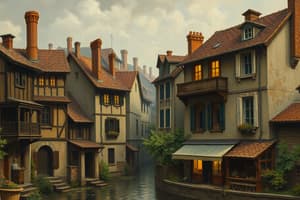Podcast
Questions and Answers
How did the living conditions of the urban working class differ from those of other social classes?
How did the living conditions of the urban working class differ from those of other social classes?
Many could only afford to live in tenements.
What attracted people to cities in the 1800s?
What attracted people to cities in the 1800s?
Offered more and better-paying jobs, electricity, modern plumbing, and entertainment.
What was working life like for working-class families?
What was working life like for working-class families?
Some people were better off than others.
What types of problems developed due to the rapid growth of urban areas?
What types of problems developed due to the rapid growth of urban areas?
Why were political machines so influential in cities?
Why were political machines so influential in cities?
What is a skyscraper?
What is a skyscraper?
What is a tenement?
What is a tenement?
What is a political machine?
What is a political machine?
Who is a party boss?
Who is a party boss?
What is graft?
What is graft?
What is mass transit?
What is mass transit?
What are cable cars?
What are cable cars?
Who is Frank J. Sprague?
Who is Frank J. Sprague?
What was created to address congestion in large cities?
What was created to address congestion in large cities?
What were the boundaries between neighborhoods created by?
What were the boundaries between neighborhoods created by?
What is industrialization?
What is industrialization?
What were 'women's clubs' focused on?
What were 'women's clubs' focused on?
What were domestic servants' working conditions like?
What were domestic servants' working conditions like?
What urban problems arose during rapid city growth?
What urban problems arose during rapid city growth?
Who are criminals in urban areas characterized as?
Who are criminals in urban areas characterized as?
What caused disease and pollution in urban areas?
What caused disease and pollution in urban areas?
Who is George Plunkitt?
Who is George Plunkitt?
Who is William 'Boss' Tweed?
Who is William 'Boss' Tweed?
Who is Thomas Nast?
Who is Thomas Nast?
Flashcards are hidden until you start studying
Study Notes
Urban Living Conditions
- Urban working class often lived in tenements, which were crowded, dark, and barely met living standards.
- Separation by class created boundaries within neighborhoods, with significant disparities in living conditions.
Attraction to Cities
- Cities in the 1800s offered better job opportunities, access to electricity, modern plumbing, and various forms of entertainment.
Working-Class Families
- Life for working-class families varied widely; some experienced better circumstances than others due to differing employment opportunities.
Urban Growth Issues
- Rapid urban expansion led to increased crime, violence, pollution, disease, and fire risks.
Political Machines
- Political machines gained influence by offering city residents essential services such as jobs, housing, food, heat, and police protection.
- A party boss is the individual in control of a political machine, often manipulating local government for political gain.
Graft and Corruption
- Graft refers to acquiring money through dishonest means, such as bribery in political contexts.
Transportation Innovations
- Mass transit systems were developed for efficient movement of city populations.
- Elevated railroads and subways were introduced to mitigate congestion in large cities.
- The electric trolley car was invented by Frank J. Sprague, revolutionizing urban transportation.
- Cable cars were pulled along tracks using underground cables.
Impact of Industrialization
- Industrialization led to an expansion of the middle class, which included professions like doctors, lawyers, engineers, and teachers.
- Women often worked as domestic servants, facing long hours, low wages, and social isolation.
Urban Crime and Health
- Crowded living conditions fostered criminal activity from pickpockets and thieves.
- Poor sanitation practices exacerbated health issues; improper sewage often contaminated drinking water, while horse manure and smoke pollution from fires degraded urban environments.
Key Figures in Politics
- George Plunkitt emerged as a powerful political boss in New York City.
- William "Boss" Tweed was a prominent leader of Tammany Hall, known for his corrupt practices.
- Thomas Nast was an outspoken critic of political machines and their influence.
Women's Societies
- "Women's clubs" focused on social, educational, charitable, and reform activities, promoting community engagement among women.
Studying That Suits You
Use AI to generate personalized quizzes and flashcards to suit your learning preferences.




